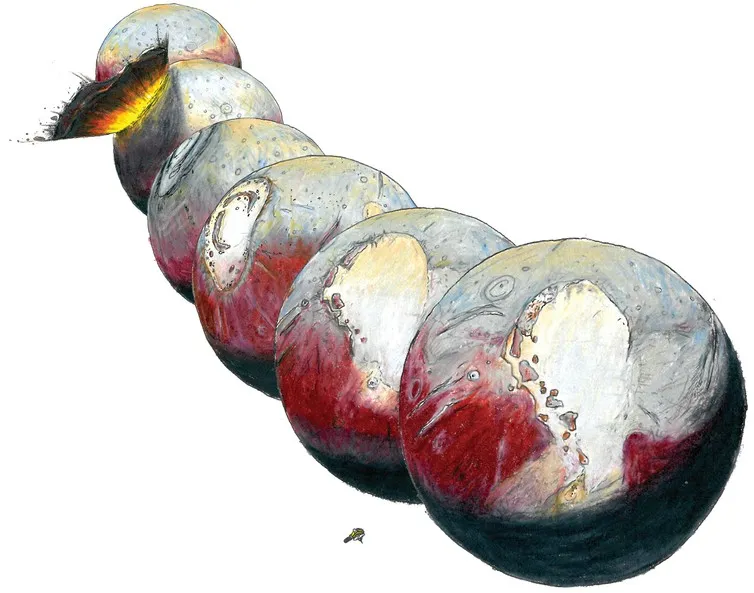It may have been more than a year since NASA’s New Horizon spacecraft whizzed past Pluto, but the data it captured is still helping space scientists make important new discoveries about the enigmatic dwarf planet. Now two new studies, published in Nature, have shed light on Pluto’s past and present structure by investigating an impact crater located in Pluto’s heart-shaped “Tombaugh Regio” area.
The solar system formed from a spinning cloud of material that collapsed under gravity. Most of the planets in the solar system spin approximately in the same direction as a result of that initial spin. Differences from this simple picture – such as Uranus orbiting the sun on its side – are produced by collisions and the force of gravity. Changes in the surface and interior of planets and moons can also reorient them, heating the interior and cracking surfaces as they happen.
The new studies show that this might have been at work in “Sputnik Planitia”, a large basin in Tombaugh Regio, on Pluto. Sputnik Planitia is named after Earth’s first artificial satellite and is about 1,000km wide and 2-3km deep. It’s believed that it was produced by a meteor impact, similar to Meteor Crater in Arizona, US. Since this putative impact, the basin has filled with nitrogen and methane ice, and traces of carbon monoxide ice.

Wandering poles
The presence of this impact basin acted to change the “balance” of Pluto. Imagine what would happen if you spun around and someone suddenly put a heavy shopping bag in one of your hands. Your balance would be changed and how you spin would change. The formation of Sputnik Planitia changed the distribution of mass inside Pluto; described by a quantity known as the moment of inertia. When the moment of inertia changes the body reorients itself, tipping over until a new equilibrium is reached. The poles of the planet thus “wander”, in Pluto’s case by about 20 degrees. But how can we know that this really happened? The smoking gun for this process is the location of an anomaly near the equator, which is exactly what Sputnik Planitia represents. So its mere existence is proof.

An impact basin is known as a “negative” topography feature – a dip in the landscape – and so might be thought of as a negative mass anomaly. But polar wander can also be caused by a “positive” topography feature – like a mountain, or a mountain range. However, where the poles wander depends on whether the anomaly is positive or negative. In reality, a planet or moon is not a perfect sphere and tides also play a role in the reorientation process. This can tell us more about the Sputnik Planitia anomaly.

In the Earth-moon system a line can be drawn through the Earth, moon, and the high-tide points: the tidal axis. During true polar wander, positive mass anomalies tend to line up with the tidal axis and negative mass anomalies with the rotational axis of the planet. The fact that Sputnik Planitia is also on the Pluto-Charon (Pluto’s moon) tidal axis shows that it is a positive mass anomaly – the result of volatile ices filling the basin.
An ocean below the cracked surface?
During this process of changing shape, the surface can crack, producing characteristic tectonic patterns. These have also been seen in the surface of Pluto, supporting Sputnik Planitia’s role in producing Pluto’s current orientation. Future studies of these cracks, and how they are changed by the ongoing geological activity on Pluto, may help us to eventually determine the age of Sputnik Planitia.

The story doesn’t end here. Even if an ancient impact carved out a 7km deep basin which subsequently filled with nitrogen and methane ice, the researchers argue that it wouldn’t produce a positive anomaly large enough to cause Pluto’s 20 degree reorientation. The nitrogen ice layer would have to be an implausibly thick 40km.
Studies of our moon show that during collisions, uplift of the mantle can make such positive anomalies. This is unlikely at Pluto since the rocky mantle is at great depth. But the impact with an icy crust over a sub-surface ocean, and subsequent uplift of that ocean, could produce an anomaly large enough to explain Pluto’s current orientation and Sputnik Planitia’s location. The ocean would probably contain ammonia due to ammonia’s low freezing point.
This adds to the growing list of bodies in the outer solar system (including for example Europa, Ganymede, Enceladus, Titan) where evidence for subsurface oceans has been presented. Subsurface oceans may be ubiquitous in the solar system and hint at what might be found at Uranus and Neptune, or further out in the Kuiper belt. Extremophilic organisms are found to thrive wherever there is liquid water. So although the presence of life in these oceans is open for debate, the probability is high enough for us to try to look for it.
Subscribe to BBC Focus magazine for fascinating new Q&As every month and follow @sciencefocusQA on Twitter for your daily dose of fun science facts.